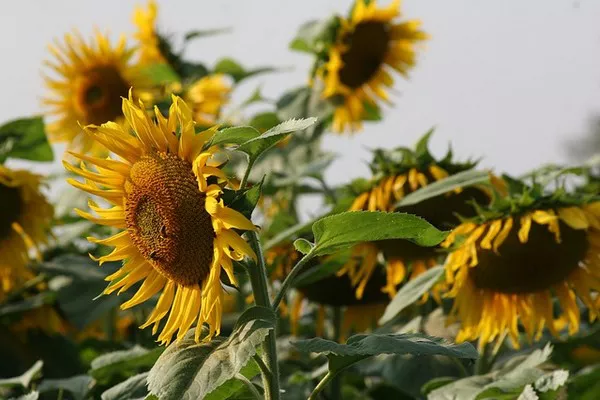Sunflowers, with their vibrant yellow petals and imposing stature, have long captivated the human imagination. These iconic blooms not only brighten gardens and landscapes but also hold a deeper, symbolic meaning that transcends their physical beauty. In this article, we will delve into the rich history and profound significance of sunflowers, exploring their cultural, artistic, and spiritual connotations.
A Brief Botanical Overview
Before we explore the symbolic meanings of sunflowers, let’s begin with a brief botanical overview. Sunflowers, scientifically known as Helianthus annuus, belong to the Asteraceae family and are native to North and Central America. These annual plants are characterized by their tall, sturdy stems and large, disk-shaped flower heads. The bright yellow petals radiate from a central disk, which consists of numerous tiny florets packed closely together. Sunflowers are known for their ability to turn their faces toward the sun, a phenomenon known as heliotropism, which makes them unique among flowers.
Cultural Significance
Sun Worship and Ancient Civilizations
The connection between sunflowers and the sun is deeply rooted in history. Many ancient civilizations, including the Incas and Aztecs, regarded the sunflower as a symbol of their sun gods. The Inca Empire, for instance, worshiped the sun god Inti and often used sunflower motifs in their art and religious ceremonies. In these cultures, the sunflower represented strength, vitality, and the life-giving power of the sun.
Native American Traditions
Native American tribes have also held sunflowers in high regard for centuries. They considered sunflowers to be a symbol of harvest, sustenance, and fertility. The seeds of the sunflower were a valuable food source, and the plant played a central role in various tribal rituals and ceremonies. The flower’s vibrant yellow color was associated with the sun’s life-giving energy.
Victorian Era and Language of Flowers
During the Victorian era, a complex language of flowers developed, allowing people to express their feelings and sentiments through floral arrangements. In this language, sunflowers were often associated with adoration and loyalty. They conveyed messages of admiration and deep respect, making them a popular choice in bouquets exchanged between friends and lovers.
Artistic Inspiration
Sunflowers have not only inspired cultures but also artists throughout history. One of the most famous depictions of sunflowers is the series of paintings created by the Dutch Post-Impressionist artist Vincent van Gogh. His “Sunflowers” series, particularly the “Sunflowers” painting from 1888, is an iconic representation of these flowers. Van Gogh’s use of vibrant yellows and rich textures in his sunflower paintings captures the essence of these blooms, conveying a sense of joy, vitality, and beauty.
The profound connection between artists and sunflowers is not limited to van Gogh. Numerous painters, photographers, and other artists have drawn inspiration from these radiant flowers, using them as subjects to explore themes of nature, beauty, and the passage of time.
Spiritual and Philosophical Significance
Beyond their cultural and artistic significance, sunflowers have held spiritual and philosophical importance in various contexts.
Enlightenment and Growth
Sunflowers’ unique ability to follow the sun’s path across the sky has been seen as a symbol of spiritual enlightenment and growth. They remind us to turn towards the light, seek knowledge, and strive for personal development. In this way, sunflowers serve as a reminder of the journey toward self-improvement and self-realization.
Resilience and Positivity
Sunflowers have a remarkable ability to thrive in adverse conditions. They can grow in poor soil, withstand drought, and endure harsh weather. This resilience has led many to view them as symbols of positivity and hope, inspiring us to face life’s challenges with a resilient spirit.
Connection to the Divine
In some spiritual beliefs, sunflowers are seen as a symbol of the connection between the physical and spiritual worlds. The radiant petals and the central disk of a sunflower are said to represent the earthly and divine realms, respectively, reminding us of the interplay between the material and the spiritual aspects of life.
Environmental Significance
Sunflowers are not only symbolically significant but also play a crucial role in the environment. Here are a few ecological aspects to consider:
Pollinators and Biodiversity
Sunflowers are excellent sources of nectar and pollen, attracting a wide range of pollinators, including bees, butterflies, and birds. Their presence in gardens and fields supports biodiversity and contributes to the health of ecosystems.
Soil Improvement
Sunflowers have deep roots that can help improve soil quality by breaking up compacted soil and extracting toxins. They are often used in phytoremediation projects to detoxify contaminated soil.
Sustainable Agriculture
Sunflower oil, extracted from sunflower seeds, is a versatile and healthy cooking oil. Additionally, sunflower seeds are a nutritious snack. Sunflower farming can be sustainable, providing valuable resources for human consumption and industrial use.
Conclusion
In conclusion, sunflowers are more than just a stunning addition to gardens and landscapes. They carry a rich tapestry of cultural, artistic, spiritual, and environmental meanings. Whether as symbols of strength, resilience, or spiritual enlightenment, or as a source of inspiration for artists and poets, sunflowers continue to captivate and uplift the human spirit. As we gaze upon their golden petals and stand in awe of their towering stalks, we are reminded of the profound connection between nature and humanity, and the timeless beauty of the sunflower, nature’s golden messenger.


